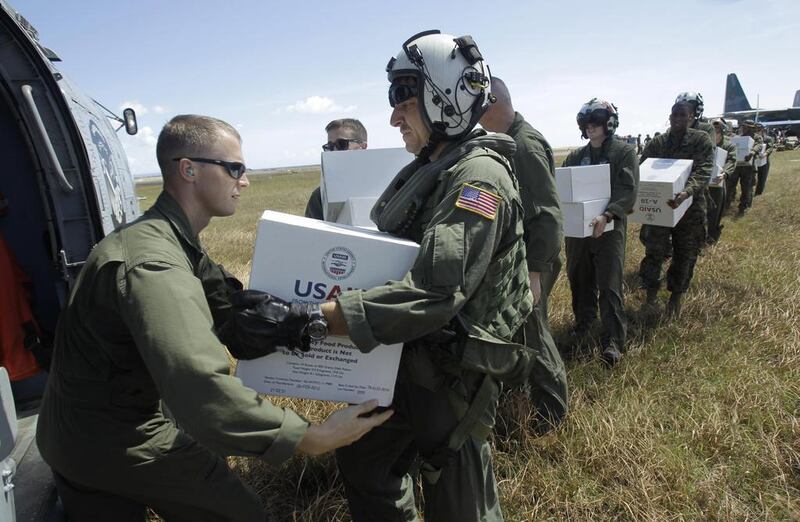ABOARD USS GEORGE WASHINGTON, PHILIPPINES // US navy helicopters and planes on Friday launched non-stop aid flights to desperate survivors of a super typhoon in the Philippines that killed thousands.
On the USS George Washington a continuous stream of helicopters landed and took off from the carrier as they shuttled supplies to the devastated city of Tacloban and remote villages.
“The USS George Washington is delivering water, medical supplies and hygienic supplies” to towns worst hit by Super Typhoon Haiyan,” the US Seventh Fleet spokesman Lieutenant David Levy said.
The United Nations said almost 4,500 had been confirmed killed in the typhoon – one of the strongest ever recorded – and the lives of many others were hanging by the thinnest of threads, even as the relief operations moved up a gear.
The Philippines’ disaster agency upped their toll to 3,621 as the government and the UN continued to disagree over the count.
In Tacloban city’s only functioning hospital, without a roof, power or water, a woman frantically pumped air into the lungs of her husband, lying critically ill a day after his leg was amputated.
Valentina Gamba, the head of nursing at the hospital, said they had tried to discharge patients who they could not feed.
“But they still stayed for shelter ... because they cannot go home,” Ms Gamba said.
Several kilometres away at the city’s airport, hundreds of famished and homeless survivors hoping to escape stricken Leyte island looked on as US soldiers unloaded aid from aircraft onto lorries.
Emergency supplies have been excruciatingly slow to get through to increasingly desperate survivors, with United Nations humanitarian chief Valerie Amos admitting that the delivery of relief goods had not been quick enough.
The USS George Washington Strike Group, with 5,000 sailors on the carrier alone, and seven other ships, arrived on Thursday with badly needed equipment, manpower and expertise, giving some hope that the delivery of aid would speed up.
“I heard there are now American planes,” Merly Araneta, 28, said.
“I will try to make it to the airport. But I have only eaten twice in five days and drank rainwater collected in a plastic cup. I am so tired.”
Ships and planes from Asia Pacific nations and Europe are converging on the Philippines, bearing food, water, medical supplies, tents and other essentials.
China has upped its aid contribution after its initial offer of US$100,000 (Dh367,000) was widely criticised, and its state media increased the pressure on Beijing on Friday, urging it to join other countries in deploying warships.
Hong Kong said on Friday it will contribute $5.16 million to a fund that can be used to help the typhoon-stricken Philippines, after drawing fire for sticking to a deadline on sanctions against Manila over a 2010 hostage crisis.
On Tacloban’s streets, the sense of want is gnawing for a population in dire need of the basics of life.
In a heavily damaged school that had been turned into a makeshift shelter for 1,000 people, Alita Nabelga, 81, said water was starting to get through but that there was no food or medicine.
“It is so hard for us here. There is nothing to eat. There is water that is rationed. But it would be better if there was food.”
Aid agencies welcomed the USS George Washington’s arrival.
“It will probably stabilise the situation for people in remote communities who remain isolated,” the Red Cross spokesman Patrick Fuller said.
“What is critical is that we humanitarian organisations have good cooperation with the military. It’s crucial that good civil-military operations work effectively. We have experience in places like Haiti where there was some communication gap.”
Dead bodies still lay by the side of the road on Friday, and the smell of rotten flesh hung in the air, despite many corpses being put in bags ready for mass burial.
While the retrieval of the dead continues, there are growing fears for the health of those who survived.
The World Health Organisation says there are significant injuries that need to be dealt with – open wounds that can easily become infected in the sweltering tropical heat.
Experts warn that a reliable supply of clean drinking water is vital if survivors are to avoid diarrhoea, which can lead to dehydration and death, especially in small children.
* Agence France-Presse





